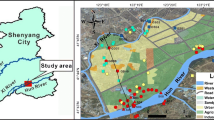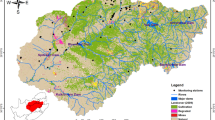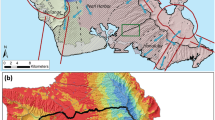Abstract
The groundwater quality of the Upper Pearl River Watershed (UPRW) and surface water quality of the basin’s outlet, Ross Barnett Reservoir (RBR), are critically important because of growing demands for drinking, agriculture, and industrial use in the region. To identify factors affecting water quality and characterize the surface water outlet and the watershed’s groundwater, geochemical and statistical analyses were performed using results from various hydrogeochemical parameters. Based on surface geology, groundwater samples analyzed (n = 51) within the watershed were partitioned into three recharge zones: North, Mid, and South. Precipitation and rock-water interactions were identified to dominantly influence the groundwater chemistry in the region. The chemistry of the surface water samples (n = 9), on the other hand, was influenced more by precipitation with minor contribution from the proximal aquifer system. Principal component analysis (PCA) revealed that two groundwater recharge zones and RBR samples exhibited significant clustering. The groundwater had a complex array of parameters influencing its chemistry owing to diverse properties, including Na, Ca, Mg, alkalinity, and conductivity. Comparing land use at the sub-watershed level with the water quality parameters showed that agriculture and development could have contributed nitrate, especially to the groundwater in the south zone. However, a general lack of distinct relationship between land use and water quality, along with detection of excess nitrate in select wells suggested that the water in the region was likely affected by point sources, such as poultry farms. The research recommends evaluating point sources of pollution to cater to future water management in the region.




source for Na may likely include weathering of silicate minerals in the aquifer (a); calcite, dolomite, and gypsum dissolution processes could be occurring, but are limited (b, c); and excess alkalinity was balanced by alkalis (d)

Similar content being viewed by others
References
Ali, W., Rasool, A., Junaid, M., Zhang, H. (2018). A comprehensive review on current status, mechanism, and possible sources of arsenic contamination in groundwater: a global perspective with prominence of Pakistan scenario. Environmental Geochemistry and Health, 1-24.
Baughman, W. (1971). Rankin County geology and mineral resources. (p. 115). Mississippi Geological.
Cattell, R., & Jaspers, J. (1967). A general plasmode (No. 30-10-5-2) for factor analytic exercises and research. Multivariate Behavioral Research Monographs, 67(3), 211.
Crider, A., & Johnson, L. (1906). Summary of the underground-water resources of Mississippi. Government Printing Office, 159.
Coupe, R., Thurman, E., & Zimmerman, L. (1998). Relation of usage to the occurrence of cotton and rice herbicides in three streams of the Mississippi Delta. Environ Sci. Tech, 32(23), 3673–3680.
Dash, P., Silwal, S., Ikenga, J., Pinckney, J., Arslan, Z., & Lizotte, R. (2015). Water quality of four major lakes in Mississippi, USA: Impacts on human and aquatic ecosystem health. Water, 7(9), 4999–5030.
Dockery. D., & Thompson, D. (2016). The geology of Mississippi, Jackson: University Press of Mississippi 751.
Edmunds, W., & Shand, P. (2009). Groundwater baseline quality, natural groundwater quality. Blackwell Publishing Ltd Oxford, 1-21.
Escher, B., Baumgartner, R., Koller, M., Treyer, K., Lienert, J., & McArdell, C. (2011). Environmental toxicology and risk assessment of pharmaceuticals from hospital wastewater. Water Research, 45(1), 75–92.
Fianko, J., Adomako, D., Osae, S., Ganyaglo, S., Kortatsi, B., Tay, C., & Glover, E. (2010). The hydrochemistry of groundwater in the Densu River Basin. Ghana. Environ Monitoring Assess, 167(1–4), 663–674.
Gandl, L. (1982). Characterization of aquifers designated as potential drinking-water sources in Mississippi. US Geological Survey No. 81-550.
Ganyaglo, Y., Osae, S., Dampare, S., Fianko, J., Bhuiyan, M., Gibrilla, A., & Osei, J. (2012). Preliminary groundwater quality assessment in the central region of Ghana. Environmental Earth Sciences, 66(2), 573–587.
Helena, B., Pardo, R., Vega, M., Barrado, E., Fernandez, J., & Fernandez, L. (2000). Temporal evolution of groundwater composition in an alluvial aquifer (Pisuerga River, Spain) by principal component analysis. Water Res, 34(3), 807–816.
Hernando, M., Mezcua, M., Fernández-Alba, A., & Barceló, D. (2006). Environmental risk assessment of pharmaceutical residues in wastewater effluents, surface waters and sediments. Talanta, 69(2), 334–342.
Khanal, S., & Parajuli, P. (2013). Evaluating the impacts of forest clear cutting on water and sediment yields using SWAT in Mississippi. Journal of Water Resource and Protection, 5(04), 474.
Kölle, W., Strebel, O., Böttcher, J. (1987). Reduced sulphur compounds in sandy aquifers and their interactions with groundwater. In G.P. Jones (Ed.), Groundwater Monitoring and Management (Proceedings of Dresden Symposium) (pp. 23-30), IAHS Press, Oxfordshire, UK.
Kumar, P., Elango, L., & James, E. (2014). Assessment of hydrochemistry and groundwater quality in the coastal area of South Chennai. India. Arabian J Geosci, 7(7), 2641–2653.
Lang, J. (1972). Geohydrologic summary of the Pearl River Basin, Mississippi and Louisiana. USGS Geological Survey Water-Supply Paper 1899-M.
Lecher, A., Mackey, K., Kudela, R., Ryan, J., Fisher, A., Murray, J., & Paytan, A. (2015). Nutrient loading through submarine groundwater discharge and phytoplankton growth in Monterey Bay. CA. Environ Sci Tech, 49(11), 6665–6673.
Loftis, J. (1996). Trends in groundwater quality. Hydrol Processes, 10(2), 335–355.
Meybeck, M. (1987). Global chemical weathering of surficial rocks estimated from river dissolved loads. American Journal of Science, 287(5), 401–428.
MDEQ - Mississippi Department of Environmental Quality. (2007). Citizen’s guide to water quality in the Pearl River Basin. Mississippi Department of Environmental Quality 1–31. https://www.mdeq.ms.gov/wp-content/uploads/2008/09/Pearl-River-Basin_Final_pr.pdf. Accessed 20 April 2019.
MDEQ - Mississippi Department of Environmental Quality. (2009). Pearl River Basin total maximum daily load reports. Mississippi Department of Environmental Quality. https://www.mdeq.ms.gov/wp-content/uploads/TMDLs/Pearl/Pearl%20River%20Basin%20%20FINAL%20Sediment%20TMDL.pdf. Accessed 20 April 2019.
MDEQ - Mississippi Department of Environmental Quality. (2018). State of Mississippi Water Quality Assessment. Section 305 (b) Report. https://www.mdeq.ms.gov/wp-content/uploads/2019/01/2018_305bReport_Final-002.pdf. Accessed 30 April 2019.
Mostaza-Colado, D., Carreño-Conde, F., Rasines-Ladero, R., & Iepure, S. (2018). Hydrogeochemical characterization of a shallow alluvial aquifer: 1 baseline for groundwater quality assessment and resource management. Sci Total Environ, 639, 1110–1125.
Narany, T., Ramli, M., Aris, A., Sulaiman, W., Juahir, H., Fakharian, K. (2014). Identification of the hydrogeochemical processes in groundwater using classic integrated geochemical methods and geostatistical techniques, in Amol-Babol plain, Iran. The Scientific World Journal.
Novotny, V. (1999). Diffuse pollution from agriculture—a worldwide outlook. Water Sci Tech, 39(3), 1–13.
Oakley, W. (1984). The ground-water resources in the Ross Barnett Reservoir area. Mississippi. Water-Resources Investigations Report, 84, 4160.
Parajuli, P. (2010). Assessing sensitivity of hydrologic responses to climate change from forested watershed in Mississippi. Hydrol Processes, 24(26), 3785–3797.
Parajuli, P. (2012). Comparison of potential bio-energy feedstock production and water quality impacts using a modeling approach. J Water Res Protection, 4(09), 763.
Rao, N. (2008). Factors controlling the salinity in groundwater in parts of Guntur district, Andhra Pradesh. India. Environ Monitoring Assess, 138(1–3), 327–341.
Saeedi, M., Abessi, O., Sharifi, F., & Meraji, H. (2010). Development of groundwater quality index. Environ. Monitoring Assess, 163(1–4), 327–335.
Schilling, K., Jha, M., Zhang, Y., Gassman, P., Wolter, C. (2008). Impact of land use and land cover change on the water balance of a large agricultural watershed: Historical effects and future directions. Water Resources Research, 44(7).
Stacklies, W., Redestig, H., Scholz, M., Walther, D., & Selbig, J. (2007). pcaMethods—a bioconductor package providing PCA methods for incomplete data. Bioinformatics, 23(9), 1164–1167.
Thompson, D., Grosz, A., Schruben, P., & Grossman, J. (2002). Solid-phase geochemical survey of the state of Mississippi: On the nature and distribution of AS, SE, HG, CU, PB, and ZN in stream sediments and soils. Journal of the Mississippi Academy of Sciences (Geology and Geography), 47(2), 142–143.
U.S. Census Bureau (USCB). (2012). Mississippi 2010 Population and Housing Unit Counts. https://www.census.gov/prod/cen2010/cph-2-26.pdf. Accessed 22 April 2019.
Wakida, F., & Lerner, D. (2005). Non-agricultural sources of groundwater nitrate: a review and case study. Water Research, 39(1), 3–16.
Wang, L., Mei, Y., Yu, K., Li, Y., Meng, X., & Hu, F. (2019). Anthropogenic effects on hydrogeochemical characterization of the Shallow Groundwater in an arid irrigated plain in Northwestern China. Water, 11(11), 2247.
Wenning, R., & Erickson, G. (1994). Interpretation and analysis of complex environmental data using chemometric methods. TrAC Trends in Analytical Chemistry, 13(10), 446–457.
Yang, N., Winkel, L., & Johannesson, K. (2014). Predicting geogenic arsenic contamination in shallow groundwater of South Louisiana. United States. Environ Sci Technol, 48(10), 5660–5666.
Yang, Q., Li, Z., Ma, H., Wang, L., & Martín, J. (2016). Identification of the hydrogeochemical processes and assessment of groundwater quality using classic integrated geochemical methods in the Southeastern part of Ordos basin, China. Environ Pollution, 218, 879–888.
Yeates, G. W., Orchard, V. A., Speir, T. W., Hunt, J. L., & Hermans, M. C. C. (1994). Impact of pasture contamination by copper, chromium, arsenic timber preservative on soil biological activity. Biol Fertility Soils, 18(3), 200–208.
Acknowledgements
The authors extend their sincere appreciation to the following generous people for allowing us to collect the groundwater and Ross Barnett Reservoir samples: Mr. Wayne Smith, NW Kemper Water Association; Mr. Glen Goldman and Mr. Wesley Spears, Central MS Water; Mr. Mike Snow; Mr. Wayne Greene, Louisville Utilities; Mr. Rick Vowell, Choctaw Water Association; Mr. Les Clarke, Kosciusko Light and Water; Mr. Richard Pope, H and H Water Association; Mr. David Langford, Lena Water Association; Mr. Terryl Hobby, Pelahatchie, Morton, and Forest Water Associates; Mr. Dale Edgar, North Leak County well operations; Mr. Mike McCullum and Mr. Mark McMannus, Town of Ridgeland Water Association; Mr. Matt Reed, City of Madison Water Association; Mr. Andy Boyd of Pisgah and Fannin Water Associates; Langford Water Association, Brandon, Mississippi; and Mr. Steve Clarke, the Pearl River Valley Water Supply District. Finally, we acknowledge the input and guidance of Dr. Darrel Schmitz, Professor (Retd.), Mississippi State University.
Funding
Financial support is provided by the Office of Research and Economic Development and College of Arts and Sciences at Mississippi State University.
Author information
Authors and Affiliations
Corresponding author
Additional information
Publisher's Note
Springer Nature remains neutral with regard to jurisdictional claims in published maps and institutional affiliations.
Supplementary information
Below is the link to the electronic supplementary material.
Rights and permissions
About this article
Cite this article
Paul, V., Vattikuti, S., Dash, P. et al. Evaluating hydrogeochemical characteristics of groundwater and surface water in the Upper Pearl River Watershed, USA. Environ Monit Assess 193, 296 (2021). https://doi.org/10.1007/s10661-021-09045-7
Received:
Accepted:
Published:
DOI: https://doi.org/10.1007/s10661-021-09045-7




